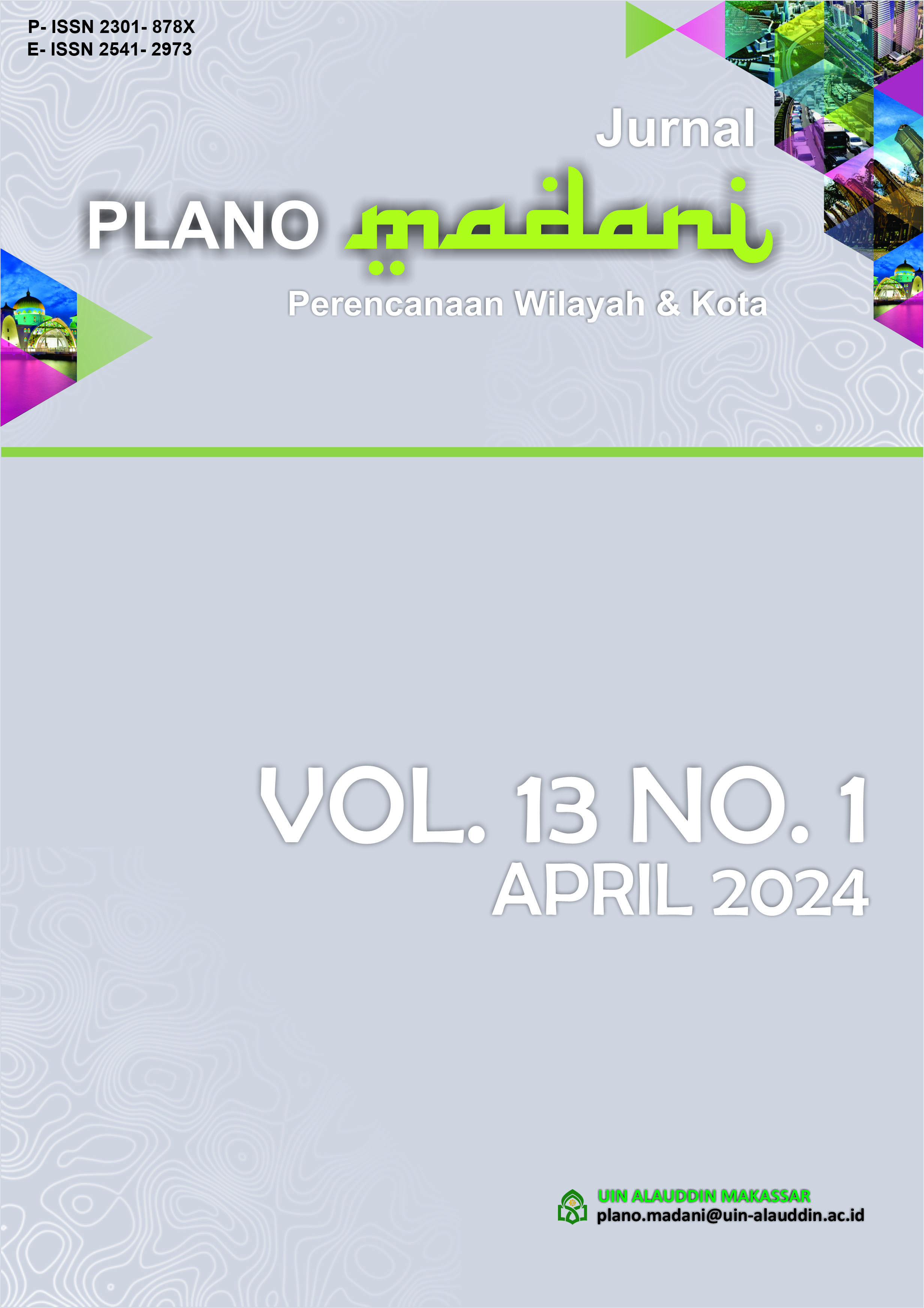MAPPING OF LANDSLIDE-PRONE AREAS BASED ON GEOGRAPHIC INFORMATION SYSTEMS IN DISASTER MITIGATION EFFORTS IN PALOPO CITY
Abstract
Research on landslide-prone areas based on geographic information systems in disaster mitigation efforts is very important because of the mushrooming of existing development on the outskirts of cities irregularly, resulting in disaster-prone cities. The purpose of the study is to determine the extent of landslide-prone areas through landslide vulnerability mapping so as to optimize disaster mitigation measures. The location of the research study is Palopo City. The research methods used are scoring, weighting and overlay methods for 5 parameters for 5 categories of landslide vulnerability. The results of the analysis of landslide-prone areas in Palopo City show a landslide-prone map with an area that is included in the safe category (2846.71 ha), the safe enough category (4585.60 ha), the vulnerable category (5237.81 ha), the quite vulnerable category (10397.54 ha) and the very vulnerable category (4676.33 ha). The resulting map provides information about landslide-prone areas to the Palopo City government, especially the Palopo City Regional Disaster Management Agency.
Downloads
References
Arsyad, U., Barkey, R., Wahyuni., & Malandung, K, K., (2018). Karakteristik Tanah Longsor di Daerah Aliran Sungai Tangka. Jurnal Hutan dan Masyarakat, 10 (1), 203-214.
Auliyan, D., Wahyuningrum N. 2021. Rainfall variability based on the Climate Hazards Group InfraRed Precipitation with Station Data (CHIRPS) in Lesti watershed, Java Island, Indonesia. IOP Conf. Ser.: Earth Environ. Sci. 874 012003.
Cakit, E., & Karwowski, W. (2018). A fuzzy overlay model for mapping adverse event risk in an active war theatre. Journal of Experimental & Theoretical Artificial Intelligence., 30 (5), 691-701
Data Informasi Bencana Indonesia (DIBI), 2023. (https://dibi.bnpb.go.id/), diakses 1 Desember 2023.
Darmawan, K., Hani’ah, H., & Suprayogi, A., Analisis Tingkat Kerawanan Banjir Di Kabupaten Sampang Menggunakan Metode Overlay Dengan Scoring Berbasis Sistem Informasi Geografis. Jurnal Geodesi Undip, 6 (1), 31-40
De Almeida, L. Q., Welle, T., & Birkmann, J. (2016). Disaster Risk Indicators in Brazil: A Proposal Based On The World Risk Index. International Journal of Disaster Risk Reduction., 17, 251–272.
Ferdi., Maliki, R,. Z., & Saputra, I. A., (2021). Flood Hazard Mapping in Baolan, Tolitoli District, Central Sulawesi. Jurnal Dialog Penanggulangan Bencana, 12 (1), 13-20.
Firdaus, M, I & Yuliani, E., (2021). Kesesuaian Lahan Permukiman Terhadap Kawasan Rawan Bencana Longsor. Jurnal Jurnal Kajian Ruang 1(2), 216-237.
Hadi, H., Agustina, S., & Subhani, A. (2019). Penguatan Kesiapsiagaan Stakeholder dalam Pengurangan Risiko Bencana Gempabumi. Jurnal Geodika, 3 (1), 30–40.
Hardianto, A., Winardi, D., Rusdiana, D,D., Putri, A,C,E., Ananda, F., Djarwoatmodjo, F, S., Yustika, F., Gustav, F, 2020. Pemanfaatan Informasi Spasial Berbasis SIG untuk Pemetaan Tingkat Kerawanan Longsor di Kabupaten Bandung Barat, Jawa Barat. Jurnal Geosains dan Remote Sensing (JGRS) Vol 1 No 1 (2020), 23-31.
Hidayat, W, Rustiadi E, Kartodihardjo H. The Impact of Mining Activity on Land Use Change and Suitability of Space Utilization: The Case of East Luwu Regency, South Sulawesi Province. Journal of Regional and City Planning. 26 (2), 130–46.
Irawan, L, Y., Safi’I, I, R., Rosyadi, I., Siswanto, Y., Munawaroh, A., Wardhani, A, K., Saifanto, B, A., 2020. Analisis kerawanan longsor di Kecamatan Jabung, Kabupaten Malang. Jurnal Pendidikan Geografi. 25 (2), 102-113
Khosiah & Ariani, A, 2017. Kerawanan Tanah Longsor di Dusun Landungan Desa Guntur Macan Kecamatan Gunungsari Kabupaten Lombok Barat. Jurnal Ilmiah Mandala Education. 3 (1), 195-200..
Longsor Kota Palopo, Sembilan Rumah Rusak Berat, 2020. (https://bnpb.go.id/berita/Longsor%20Kota%20Palopo,%20Sembilan%20Rumah%20Rusak%20Berat), diakses 1 Desember 2023.
Puslittanak Pusat Penelitian dan Pengembangan Tanah dan Agroklimat. (2004). Laporan Akhir Pengkajian Potensi Bencana Kekeringan, Banjir dan Longsor di Kawasan Satuan Wilayah Sungai Citarum-Ciliwung, Jawa Barat Bagian Barat Berbasis Sistem Informasi Geografi. Bogor.
Romshoo, S, A., Yousuf, A., Altaf, S., & Amin, M., 2021. Evaluation of Various DEMs for Quantifying Soil Erosion Under Changing Land Use and Land Cover in the Himalaya. Journal Frontiers in Earth Science. 9:782128.
Solle, M. S., & Ahmad, A. (2016). Identification of Soil, Rock and Tecto-Volcanism on Landslides in Tondano Watershed. Journal of Geological Resource and Engineering, 6, 271-282.
Wang, F., Xu, P., Wang, C., Wang, N., & Jiang, N. (2017). Application of a GIS-Based Slope Unit Method for Landslide Susceptibility Mapping along the Longzi River, Southeastern Tibetan Plateau, China. ISPRS International Journal of Geo-Information, 6(6), 172.
Widiawaty, M. A., Dede, M., & Ismail, A. (2018). Kajian komparatif pemodelan air tanah menggunakan sistem informasi geografis di Desa Kayuambon, Kabupaten Bandung Barat. Jurnal Pendidikan Geografi, 18 (1). 63-71.
Copyright (c) 2024 Wahyu Hidayat, Ridwan Sukimin

This work is licensed under a Creative Commons Attribution-NonCommercial-ShareAlike 4.0 International License.
By Submitting your manuscript to our journal, your are following Copyright & License

